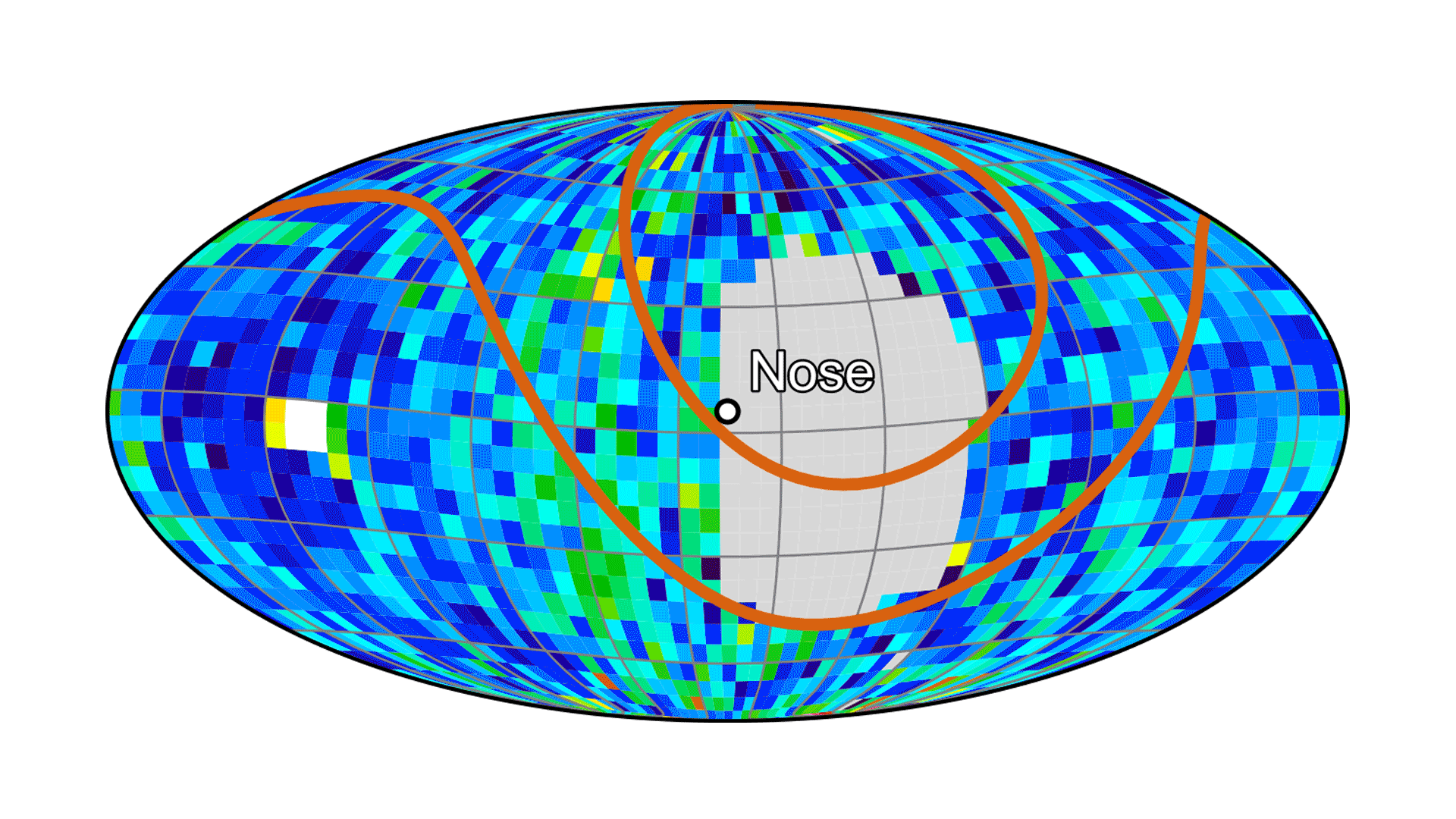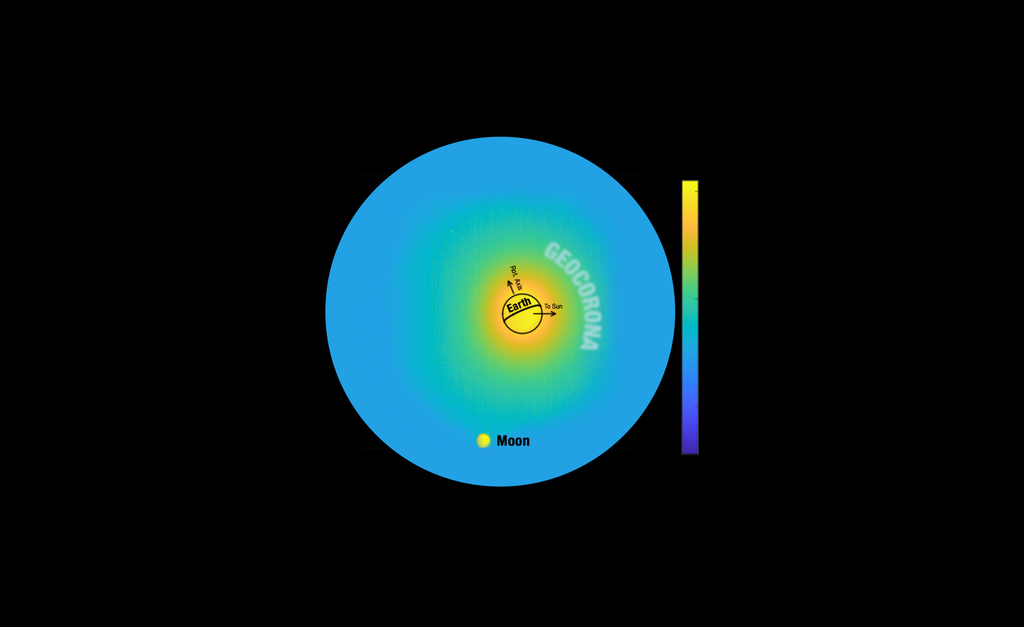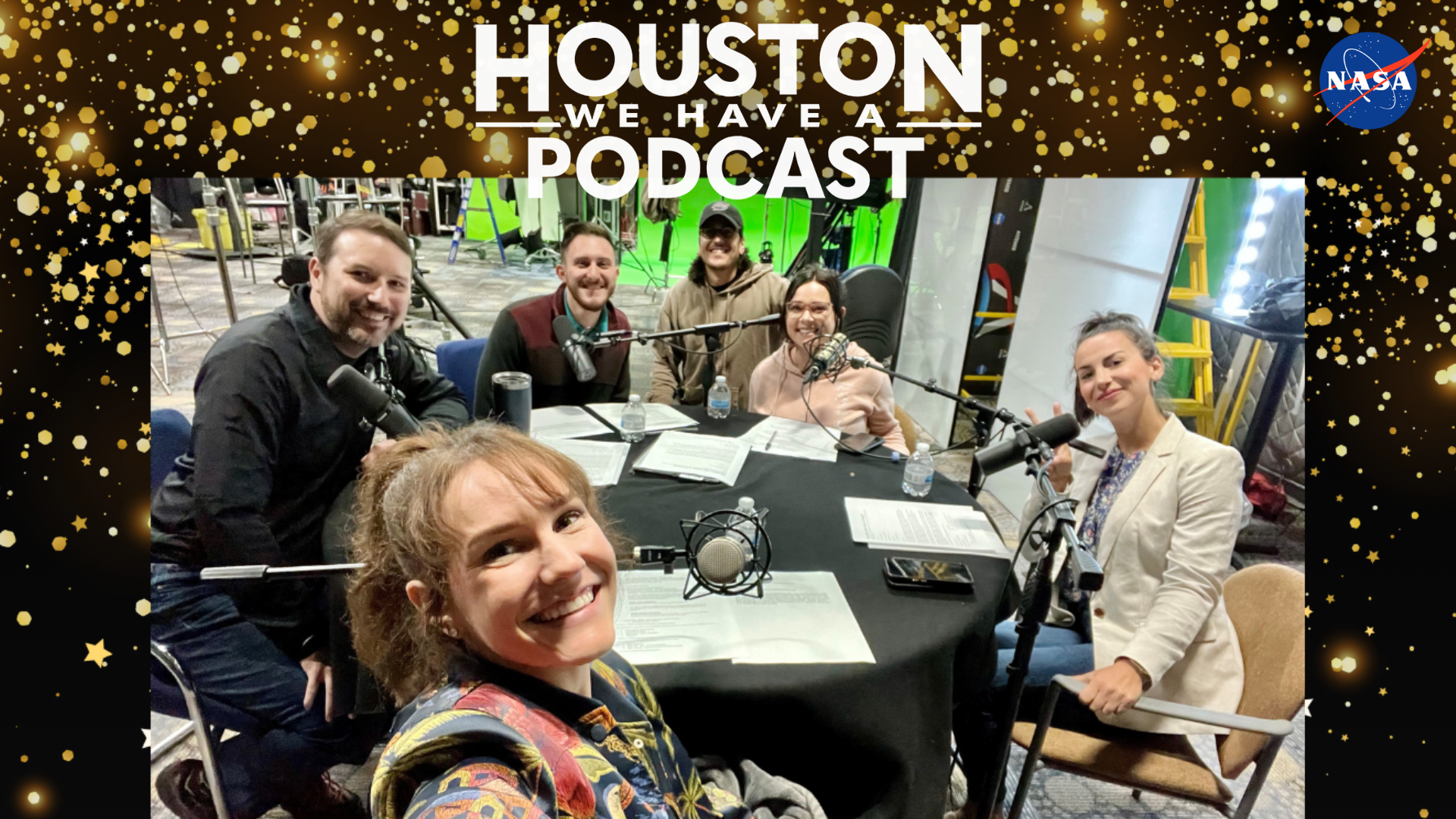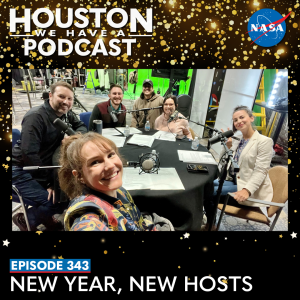
From Earth orbit to the Moon and Mars, explore the world of human spaceflight with NASA each week on the official podcast of the Johnson Space Center in Houston, Texas. Listen to in-depth conversations with the astronauts, scientists and engineers who make it possible.
On episode 343, Houston We Have a Podcast celebrates its seven–year anniversary and the hosts talk about their roles at NASA, tell fun stories, and discuss their passion for communication and human spaceflight. This episode was recorded on June 7, 2024.

Transcript
Host (Gary Jordan): Houston, we have a birthday! Welcome to the official podcast of the NASA Johnson Space Center, Episode 343, “New Year, New Hosts.” I’m Gary Jordan and I am one of many voices of Houston We Have a Podcast. We bring in the experts, scientists, engineers, and astronauts, all to let you know what’s going on in the world of human spaceflight. Seven years ago this week, we released the first episode of Houston We Have a Podcast. We’ve had such incredible conversations over this time, and the show has grown, changed, and evolved. Just this past year, we celebrated 300 episodes after our sixth year, kicked off our Mars Audio Log monthly series, which we’ll be wrapping up soon, recorded on location in a thermal vacuum chamber and chatted with 25 astronauts. We also recently started to introduce new hosts to the podcast. This is something I’ve wanted to do for quite some time, and I’ve been very happy to bring in new voices and new perspectives.
For this episode, in celebration of seven years of Houston We Have a Podcast, we bring in all of the current hosts. We all work in the same office, the Johnson Space Center’s Office for Communications under the External Relations Office. So on this episode, we talk a little more about what we do, we swap some stories, and we discuss our passion for communication and human spaceflight at NASA. Happy birthday to us! With that, let’s get right into it. Enjoy.
[Music]
Host: Alright, everybody. Happy birthday to the pod!
Leah Cheshier: Woohoo! Yay.
Kenna Pell: Happy birthday!
[Cheers]
Host: Seven years.
Leah Cheshier: Wow. Another year older.
Host: Yeah, seven. Yeah, we’re seven years old now. Another trip around the Sun.
Leah Cheshier: Another trip around the Sun. Golden birthday.
Host: Is that what it is? I thought golden was 50.
Leah Cheshier: No, well, that too, but like when you turn the age of the day. So, when I turned 28 on the 28th, that was my golden birthday. So, we’re seven on the seventh.
Host: I just learned something. I didn’t know that. I was born on the fifth, so I passed it when I was five.
Leah Cheshier: Oh, you missed it.
Host: I missed it. That stinks. Well, we’re here with another year, and I wanted to do something special to celebrate this anniversary. We do something special every year. Dane, you were there for the last year. Usually it’s comes on the first week of July, but we delayed it so we can pair the sixth anniversary with 300 episodes. So we did something real special for that one. This one though, is special in its own way because after year six, I was lucky enough to bring on brand new voices to the podcast, which is something that I’ve wanted to do for a while, but finally, finally pulled the trigger on it. I’ve been very fortunate to bring you guys on and have you do your own podcast. We’ve done small introductions for each of you to really just introduce the audience to who you are and recognize your voice. But really, I think this is a really good opportunity to do some deep dives into each of you and what your role is and what you do. And then from there, what’s nice is that we’re all in the same office. We’re all communicators. So let’s have a great discussion about communications, why we do what we do, why we’re passionate about what we do. So let’s get into it.
Dane, I want to start with you because you were the first voice that we introduced out of everybody here for episode 300. So it was great to have you on. You’ve been not only a voice, but a producer for the podcast, really making this possible. I can’t do it without you, man. So it’s great to have you on and great to have your voice.
Dane Turner: It’s really cool to not only be the producer of the podcast, but to actually be, you know, involved on the podcast occasionally. It’s a real honor to be able to do that.
Host: So you have a background in television? Tell us a little bit about yourself, how you, you know, got to where you are today.
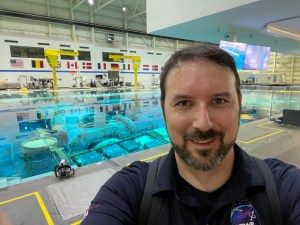
Dane Turner: Well, I went to school for film and ended up in the world of television. I worked TV news for eight years, directing TV news. I had a lot of fun doing that, but also knew that it was something that I needed to move on from. And in doing so, I ended up at Disney World and was a technician there for a while. Wanted to do some broadcast stuff, but that didn’t work out. And after about four years, I saw that NASA had an opening and came here to work on the live television, which has just been absolutely fantastic. We do all sorts of cool stuff here as everyone around the table here knows. You know, worked on DM-2 was one of my first big things. And getting to work on such a historic broadcast, it was very hands-on for me. You know, we were setting up lines to Mission Control. We were setting up our little broadcast booth in Mission Control. You know, as working with people from Headquarters, from Kennedy, from Goddard, you know, we were in contact with so many different people, and so hands on with that, it was so huge. And I hadn’t even been here for a year when that happened.
Host: Wow. They threw you right into the fire.
Dane Turner: Right into the fire. Like, it’s awesome.
[Laughs]
Kenna Pell: Full circle with Starliner now, too.
Dane Turner: Yeah. And Starliner just launched. I haven’t been nearly as involved in that one, but I’ve been involved in very different ways. I’ve changed roles since then.
Host: Yeah. So what do you do now?
Dane Turner: So I was a live television producer working very much on our live broadcasts. And now I’m our multimedia content producer, which means I produce the podcast, I produce a lot of our videos that are the biographies of the astronauts, that are the mission overviews. So when you see those during the broadcast, I’m working on those packages that go on during the different broadcasts and that go onto our YouTube channel. So I’m a lot more involved in the behind-the-scenes stuff now, rather than the stuff that’s actually going out on the air live.
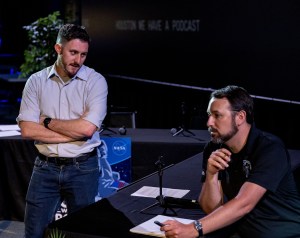
Host: But it goes out live because it takes, you know, and you’re not doing it real time, you’re doing it months of planning. There’s so much work that goes behind it. And I just know, I mean, I thank you in the beginning, but I can’t stress enough how much your dedication to thinking months out to make sure that we can produce on a weekly cadence and your attention to detail and all of that. It translates to everything you do in your job and you do. Fantastic. You make it possible, man. Thank you. Leah, the next voice of the podcast after Dane. You’ve done a couple of episodes at this point. So tell us a little bit about yourself, where you come from all that.
Leah Cheshier: I come from a very, very small town in Georgia called Breman. 5,000 people. I went to a very small college. NASA was really never on my radar as somewhere I could work. It was something I always loved and was passionate about. But when I was in college, I got invited to a NASA social, so essentially, if you have a social media account, you don’t have to be an influencer or somebody with a big following, but you can apply and be invited to come to a launch or an event or an announcement. And I applied and got accepted. And so I went up there and I actually saw one of our colleagues, Rachel Kraft, at a press briefing.
Host: You met Rachel there. That’s interesting.
Leah Cheshier: I don’t think that we got to talk, but she was the moderator. I was in school for communications, and I realized that I could do that job and NASA had a place for me. And so, I always knew that I wanted to do something on air, and now I get to do that through commentary. But since I came to NASA, you know, I started as an intern. I joined a contract after that and worked with the internship program. And then got hired on into the Public Affairs Office and have worked on social media, space station, commercial crew, Artemis, and now humans in space.
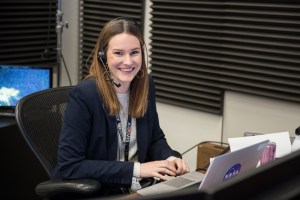
Host: So it was something that you weren’t always thinking was a goal of yours because it wasn’t possible. Or did you kind of have something in the background that was like space? I’ve always wanted space.
Leah Cheshier: It’s interesting because it’s one of those things that you don’t let yourself dream because you don’t know that you can dream it, you know? I was a communications person, and I didn’t know that. Like I said, I didn’t know it’s to dream of going to NASA. I just didn’t realize that NASA was an option for me. And so it is a dream come true. It’s just one I didn’t dream of, or I didn’t realize I could have yet.
Host: In high school, I was always interested in science and those sorts of things, and I pushed myself. I wasn’t really good at it, but I pushed myself and I took an honors physics class, and I realized in honors physics that I couldn’t do it. It was really disheartening cause I really wanted to get into these sorts of things. I found it so fascinating. I mean, as a kid, I would go to the library and take out books and actually read about scientific subjects, but in class I just couldn’t do it. So it was always behind there. And so, yeah, it was like one of those things where something that was science-related just became so distant and I would see these things and, you know, my introduction was sort of like that in that I kind of stumbled upon NASA. It wasn’t something that I was actively seeking. And it wasn’t because I didn’t care about it. It was because I didn’t think it was possible. So it was just really cool. I resonate with that story very, very much.
Leah Cheshier: Yeah. I’ve loved being here. You know, I think it’s always challenging. I think I’d be bored if I wasn’t challenged. And it’s always different. There are never two days that are the same here. Which, you know, there is some uncertainty in that too. But at the same time, I feel like I’m able to use my skills and continue to grow in them pretty much on a daily basis.
Host: You also have background and a passion for performance. Didn’t you have like a theater degree or something?
Leah Cheshier: Yeah, yeah. I’ve always grown up performing. I sing and I did musical theater. I went to college on a partial theater scholarship. And so to me it’s like getting to take everything I learned in that and bring that to on air work. Presentation and how to, you know, present yourself, diction, because I’m from Georgia, you know, if I go back long enough, I get a little bit of a southern accent. So I learned so much through that and I’m really grateful for the opportunities that I had through theater and how I’ve been able to find ways to put that into work here, even at NASA.
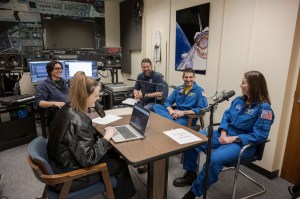
Host: Very lucky to have you. And I think it translates very well to all of this, you know, to the podcast, to on air commentary. And you do great. So thank you. Just very, very lucky to have you, Leah. Thanks. Kenna, the next voice of the podcast, and actually I think out of all of us, the newest to Johnson, right? Tell us about yourself.
Kenna Pell: Well, I hope everyone’s ear damage has gone away from my first episode on the solar eclipse. I’ll tell you what, I can talk ISS all day, but any celestial event, I go to schools, and I was at a kindergarten class and they’re saying, how far is Jupiter from Earth? I don’t know like those things, right? But I can tell you all about the ISS or the International Space Station.
Host: You know that that one was one of our most listened to podcasts?
Dane Turner: I don’t know recently if she realizes that.
Host: Did you know that?
Kenna Pell: More ears.
Host: More ears on that one.
Kenna Pell: That’s my first one. God, I’m so sorry.
Host: Most of our other ones in recent, yeah, you have more listenership on that episode than any did.
Kenna Pell: I’m glad you did not tell me that. But, you know, I wanted to mention, and this is something that I tell every time we have maybe new interns or new people in the office, or even around Johnson who don’t quite understand what our office does is we’re really kind of like the Center’s PR agency, right? So the center’s got a whole bunch of different programs. And so they need PR people or account executives of those programs to kind of help. And so, for instance, I look around the room here and I’m sitting around at this table with Gary, Courtney, Leah, you’ve all worked the ISS beat before. I’m currently in that beat now. So part of my role with strategic communications, which a lot of times I say it’s kind of the net for anything that’s not really media related, but still kind of comms related, which I love. This is my dream job. I love the International Space Station, talking about it. Love, like I said, I can talk about that more than asking me how far the Earth is from the Sun. But my friends actually joke, my friends joke. Like today my friend sent me a video of her baby reading about the planets cause they know I’m just not good at it.
Host: Really? There’s so many people that when they think about space though, I mean the first thing they think about is planets. And celestial events. It’s like one of those things. People ask me about that stuff all the time. So much. Oh, you work at NASA? Tell me about this comet. And I was like, I don’t, yeah. I don’t know. Human spaceflight man, right?
[Laughs]
Kenna Pell: I can tell you all about these astronauts. But, you know, part of strategic communications, I think for this program, what I like about it is the various audiences, right? So a lot of times with PAO, you might be talking to media or external audiences. But with, with stratcom, I feel like there’s a whole bunch of different stakeholders. So internal with your employees, which I feel like are number one stakeholders, right? Because you arm them with the best information and get them enthusiastic about what we’re doing. And they’re going to go out in the public, tell their friends and family and be excited about what we’re doing, right? So different stakeholders, internal, external events, internal comms, executive communications. And then we’re now actually supporting executive communications for the Director of the ISS up at HQ under what we call the Space Operations Mission Directorate. And so it’s cool to help with kind of headquarters comms, also Johnson comms here. And so it all kind of comes together.
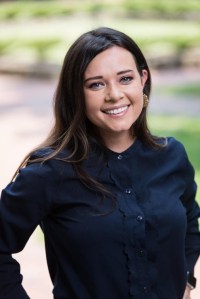
Host: So it is actually interesting cause a lot of like what we are doing, like now, what we do just in general is we reach out to very general, very broad audiences. We reach out externally. And we’ll get into this too, because I think I would love to have a discussion just in general about communications, but you have to think about your target audience, right? The general public is not your only target audience. That’s not the only thing you should be reaching out to. You talk about part of your job is reaching out to the internal community, everybody that works at this in the Space Station Program, making sure they’re engaged with everything that’s happening. Leadership, right? There’s all these different audiences that you can target and all of it has to do with how do you reach them? Communications.
Kenna Pell: Absolutely. And I am the newest here to JSC. I came from KSC over on the Space Coast of Florida. But kind of like everyone here, we haven’t heard Courtney yet, but it’s interesting how we all fell into NASA right. Into communications where we didn’t know ahead of time that’s what we wanted to do. And I think we’ve seen a really big shift in the past couple of years. I mean, a couple years ago, you couldn’t walk around Target or anywhere without seeing shirts, NASA shirts, everywhere, people wearing shirts. There were a couple articles. Like, you’ll always see someone wearing a NASA shirt. It just seems like space got really, really popular. And we’ll talk about that, I’m sure, with commercialization. But I started over at Kennedy Space Center Visitor Complex. And like Dane, in that realm of Orlando, technically, it was travel tourism. And I loved it because it was both space and travel tourism, right?
So about 45 minutes away from Orlando is the official Visitor Center of Kennedy. And what I loved about it was they told NASA’s story from the beginning to now and the future. And so that’s where I fell in love with early space. You know, I’m talking Mercury, Gemini, Apollo, those guys. And you can say guys, cause they were all guys then. And then you’ve got the shuttle, you got the shuttle program where the 35 new guys came out and they were, you know, the first ever astronauts of color, women. So hearing all the NASA history and then seeing the now, I loved that side of it. So really good at telling the NASA story in a really interactive and immersive way. If you have not seen the Atlantis attraction, you have to go. But then from there, I went over to the public affairs side at Kennedy. So Kennedy Space Center proper, so to speak. And there, I got to serve some beats that really helped me actually when I came here cause the International Space Station program is based out of Johnson. And I helped with Commercial Resupply Services launches out there. And then also cargo ships. And then also Launch Services Program. And a little bit of CCP before I came over here. But I think I had mentioned this, I always wanted to come to a big city like Houston, but I had the familiarity of the NASA family too, which was so great because I’m from the Cocoa Beach area. So fun beach town. I mean, we can go to Galveston here, but coming to Houston to a bigger city and then having the sense of the NASA family here was like the best opportunity.
Host: Yeah. I kind of fell in love with it really quickly when I came here. I came from the East Coast, and it was definitely a culture shock coming to the south.
Kenna Pell: You’re a PA guy.
Host: I am a PA guy.
Kenna Pell: Yeah. Did we talk about this? Philly, or? Sorry.
Host: A little bit. When we get to Courtney, we both were in Pittsburgh for just a little bit.
Kenna Pell: Oh, I was going to say, were you Steelers or Eagles?
Host: Well, I grew up on both sides. I was all over Pennsylvania, but, yeah, it was kind of a culture shock, but I actually minored in Spanish in college. Can’t speak much of it today cause I took NASA internships versus doing studying abroad and immersing myself into the Spanish language. But I took it specifically because I wanted to move south. I really loved… I actually went to Disney growing up as a kid. Funny enough, I never went to the Kennedy Space Center until after I worked at NASA.
Kenna Pell: Hey, now you can’t miss it.
Host: Never saw a launch. Never saw a shuttle launch me neither. Until after I worked at NASA. I never saw a shuttle launch period.
Kenna Pell: I grew up with shuttle launches.
Host: See that, I’m jealous.
Kenna Pell: With the 737, the shuttle on top if it were to land over to Edwards and seeing that fly in over the house, I mean, beyond the launches. That was, that was cool.
Host: Yeah. See that would absolutely sell you. Actually, I watched a replay of the 135 landing when I was in, I’m not going to say when, no, that was college. I was in college at the time. So I watched that when I was really starting to get interested in NASA, but it really was always in the back of my mind. I was always actually into film like Dane that was actually like, I was really into Star Wars was like a huge inspiration for me growing up. So those sorts of things were, but NASA didn’t quite get me until a little bit later. Alright. Courtney, the most recent voice and recent edition to the podcast. Very appropriate because we are talking a day after Butch and Suni docked to the International Space Station as part of the Crew Flight Test. And that was your first time on the pod. Tell us a little bit about yourself.
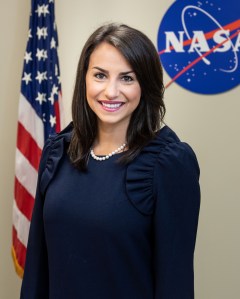
Courtney Beasley: That was my first time. And what an exciting episode. And that was a really fun one. You were there for that. They had a ton of energy and it was so exciting. And I think everyone could see their energy floating through the hatch yesterday. I was born and raised in Houston, so I’m a Space City girl growing up. I came to Space Center Houston, we did field trips there, but similar to all of you, I never thought of NASA as a place that I could work, because guess what? I was horrible at science. I was horrible at math.
Host: I relate.
Courtney Beasley: I was good at history, I was good at writing and I was really good at communicating. So for me, I thought that my only path was to go into news. And that’s what I ended up doing. I went to Southern Methodist University in Dallas. I got a journalism degree in mass communications, which covered broadcast, print, and digital media. And after school, went on to work in news for a couple of years. I did live in Pittsburgh, had a great time there, by the way. Go Steelers.
Kenna Pell: Go Browns.
Courtney Beasley: It was a great time. But I was ready to move home. My husband was ready to move home and get back to Texas. So I started looking at jobs and I saw an opening to work at NASA in public affairs. And at the time I was like, there’s no way that NASA would have a job for a communicator. But of course, they do. How else would the world know the NASA story? So I applied. I remember thinking I would never get a job at NASA. It just seems like NASA is something so much bigger than yourself. It’s a global agency and it’s recognized everywhere that you go. I remember, Leah and I were in London in December, and I remember seeing people in NASA shirts in London. And that was so cool. So I applied, I ended up getting an email from James Hartsfield, and here we are six years later, and it’s been the best time ever. I remember when I went to apply, I said to my husband, “I don’t think there’s any way that I’ll get a call back from NASA.” And he said, “Just apply. The worst thing that could happen is they could not respond and you’re still in the same position that you were before you applied.” So I did it. And it’s been the best decision ever. I get to work with the most incredible people, literally on the planet and off the planet.
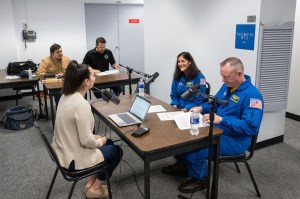
Host: I knew it was coming.
Kenna Pell: You could say, “Out of this world.”
Host: Yeah, we need at least one “out of this world.”
Courtney Beasley: So yeah, it’s been great. And Gary and Leah, you were two of the first people that I met, I think actually when I came for my interview.
Leah Cheshier: We went to lunch.
Host: That was our job. That was our job was to, you know, take Courtney out to lunch, let her know that we’re a good team. So we must have done something.
Courtney Beasley: It worked out. I was really nervous, but we had a great time.
Host: It was great to have you Now, I have a different style today because there’s all of us. And I think what’s nice is that we all work in the same office. We all do very similar things. Very passionate about, I think all of us in one way or another are very passionate about figuring out the best way to share the NASA story, to engage people. This being one of those mediums, the podcast. And so I want to do something a little bit different today. The style of this podcast is typically interviewing, asking questions with NASA experts. But I wanted to tee up some prompts and just have some active discussion with super smart communicators like yourselves. And so the first one I wanted to tee up was communication. We’re all in the Office of Communications. We all have a job. Our charter is really to reach as many people as possible, to figure out strategically how to engage people in what we’re doing and have them care. Let me start with this. What drew you to communications? Open question.
Kenna Pell: After you, Leah.
Leah Cheshier: I feel like it’s something that, like I said earlier, I always knew that I wanted to do, I always wanted to do some sort of on-air work. And, you know, that’s only a very, very, very small part of our jobs. When it comes to like, commentary and podcasts and things like that, you know, it does not take up the majority of our time. But I always wanted to work in sharing what we’re doing in a cool environment. The question was what drew me to communications?
Host: Yeah.
Leah Cheshier: I think that has changed over the years too. So initially it was because I felt like I had a strength in it. And it was something fun. And then, you know, as social media manager, it’s like, let’s make something cool. Let’s make something that people love and get them excited. And then the longer that I’m here and the more commentary that I do, it’s not just let’s show something that’s cool and exciting and people enjoy watching. But I am so exposed to the teams now that work on the programs, and I just always think about them when I’m on air of, am I accurately sharing all of the work that they’ve put into this? So I want to know as much as I can to accurately represent their systems, their products, their procedures, because, you know, they’re really the ones who spend their careers making these incredible awe-inspiring moments happen. And then beyond that, I also want them to be able to, if they’ve told their family or friends, like, hey, tune in, or hey, read this article I want their family and friends to walk away and feel like they understand what their family member does better. You know, so if they’re like, “Mom, you know, tomorrow we’re docking the spacecraft and I worked on the docking adopter,” I want them to hear a call out about that, hear it explained, and be able to walk away and say, “I saw something that you worked on today. And I understand now more of what you do.” So to me, I just want the people who work here to be proud of what they do and see it reflected.
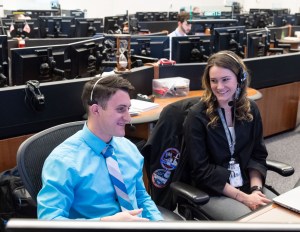
Host: It’s like the accessibility or achievability of something that just seems so distant. I think all of us have something like that. Just like, I didn’t think working at NASA was possible because NASA just seems like that’s for the smartest of smart people, right? And you just seem so separated from it. Like, you can’t connect with a person that’s actually performing the work, but if you can sort of relate to what’s happening and like, hey, you can get along and with this too, you can follow along. And it’s not like we’re closing off the barriers and saying like, “Nah, you don’t know that, you don’t know what’s going on.” You don’t understand. You know, like we’re building a bridge and be like, no, this is awesome. You can totally understand it. Here’s how I would put it in order to help to understand it.
Kenna Pell: Gary, you say the smartest people here at NASA, and one of my mottos I live by is, and it’s perfect for working here, and you’ve probably heard me say it, is that you might not be the smartest person in the room, especially working with the programs directly, but you can always be the most prepared.
Host: Oh yeah. I’ve heard you say that a number of times. That’s great. And you are, yeah. You always show up with—
Kenna Pell: Well, speaking of being prepared, I want to say my answer to how I fell into communications. This is going to sound canned and it’s kind of is because I’ve said it many times. But it goes back to, I went to school for marketing at UCF in Orlando. So University of Central Florida was actually created as a feeder school to Kennedy. It was called Florida Technical University back in the day. And their mascot was an orange astronaut. So it was like an orange with an astronaut helmet and a head on top. Oh, it’s called the Citronaut. Now it’s, gosh, University of Central Florida. So they’ve got great ties to KSC. I went there in marketing and if anyone here is familiar, I know marketing generally falls under the business school. So you’re doing a lot of finance, accounting, supply chain. And once you finally get in those marketing classes, you know, they’re pretty quick. I landed my first job after being with them in an internship, Kennedy Space Center Visitor Complex. The only reason I got this internship was because I hand printed my resume and took it to HR. They really took like a leap of faith on me. I was brand new and this really cool gig a couple years later when I graduated, didn’t have a job out of college. And I got a call from them and said, “Would you like to work with us temporarily just on the comms team?” And I had never thought about communications. It was not until I started that job that I cracked open an AP Style Guide. I had never seen one in college because marketing, you didn’t write press releases and, you know, maybe things have changed now with Leah. That’s something I wanted to talk about. You know, you starting in social media and seeing how it’s evolved over the years and maybe things have changed with marketing, but yeah, I learned everything I did on the job.
And so the canned part of this is how I fell into communications was a happy accident. And the reason I’m saying it sounds rehearsed is because I just went back to school cause I wanted formal training in communications. And so writing the college apps, I would say like, “I want to go back to school and actually learn about comms in a formal setting.” And so I just finished that. But I guess full circle, the reason I did that was not only just to get that formal education in this area I love, communicating and storytelling, but I started at community college before UCF and I want to teach PR 101 to future communicators and get them excited and find their passion that I found with storytelling for NASA in anything. So you could be, you know, you’re here in Houston where oil and gas or medical, but you could do really cool communicating for anything. And, you know, every little thing, someone’s passionate about it. So there’s always ways to find your NASA and everything you want to communicate.
Courtney Beasley: My journey into communications felt very intentional from a very young age. I always loved to tell stories. I liked to read books and then tell people what the book was about. I remember my mom telling me that when I was really little, I always had a way of explaining things. So she said one time my foot was asleep and I said that my foot was sprinkling. So just little things like that. I always was able to find a way to give an explanation for something. I told my mom when I was little I wanted to be Diane Sawyer when I grew up. And I remember going to the museum growing up and everyone would be looking at all the science stuff. And I would go straight to the broadcast booth so I could do the newscast with the weather that they have there.
So when I went to college and even in high school, I knew exactly what I wanted to do. And I hear a lot of people say that what they learned in college, they don’t use in their jobs, in their everyday jobs. But when I say that everything I learned in college, I literally use every day in my job. We learned how to use the AP Style Book. We did broadcast, we learned how to write scripts. We learned how to write press releases. So I really feel like everything I learned there translated immediately out of college. And I still use it today, which is incredible. And I reference back a lot to what I learned then now too. So it’s been really fun for me. I really feel like I’m living out my dream.
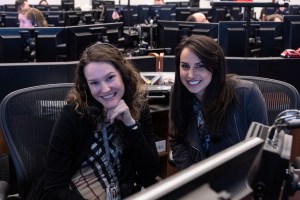
Host: After college, you can communicate in anything using any of those skills. But why news?
Courtney Beasley: I went to news because originally, I thought I wanted to be in broadcast. I wanted to be an on-air personality. And it was a great industry, and I really did enjoy it. But for some reason, I felt like a little part of something was missing. I wasn’t really telling stories that I wanted to be told at that time. Like I was reporting on a car accident. That’s not something that I really enjoyed doing. But here we get to tell stories of people flying to space and doing things that are way bigger than all of us. And for the most part, always really exciting. So, it’s been a really good transition for me.
Host: A lot of it’s like very, very positive. Did you have like a performance sort of thing? Did you ever have like a theater itch?
Courtney Beasley: I did theater in middle school. And then I did sports. So in high school that was my thing.
Host: Okay. Yeah. I tried sports, was not my thing. I tried everything. I tried football, baseball, volleyball, golf, soccer, everything. Oh, I was horrible at everything. But I found my passion. I found my skills in music and in theater. I did very, very well in those. And there was just something about, I mean, it’s the same, probably you have the same thing. You could say the same thing about sports, just being on the field and the energy and the passion that you get. Like I found it in performance. That was my thing.
Courtney Beasley: They both have translated over. Really well for me for sure. What about you?
Dane Turner: Well, Kenna and Gary kind of hit on this a little bit. My big thing about communication is storytelling. And I got here through indecisiveness. I’ve been the biggest nerd since I was little. I wanted to be an astronaut. I wanted to be a paleontologist. I was fascinated by aircraft and flight. And, you know, through everything, I’m like, well, what kind of job am I going to have? You know, you can’t be both an astronaut and a paleontologist and, you know, build airplanes and everything. And so eventually around high school, I decided, you know, I’d been watching Star Wars and Jurassic Park and all these things. I’m like, these filmmakers get to work on all the things I’m interested in. So if I’m a filmmaker, I can just choose, this project lets me, you know, this thing and then this thing. And, you know, so I was like, okay, filmmaking’s great. I get to tell people’s stories about all of these different things. And so that kind of translated into I went into to broadcasting. It’s like, like Courtney said, you know, we’re telling people stories through the news, but also, like you said, we’re reporting on car crashes and shootings. And that’s just it. It’s really depressing day after day. And so you find something else that’s going to make you happy. And eventually, you know, again, like everyone has said, you don’t think about NASA when you think about communicating, but it’s so important. And when I worked at the TV station, we had NASA TV on one of our satellite feeds, and I would watch that every morning while I was on the news. That was one of the screens that I had up in the corner of my display. And I could watch that rocket on the pad. And I was ready to, you know, during the commercial break, watch that launch. And so being able to come here and put those launches on air myself, and to work with these astronauts to tell their stories, that is something that never thought was possible, but has been so fulfilling to get to talk to these astronauts, find out what makes them tick, and then tell the American public, the world, what’s going on here at NASA.
Host: Yeah.
Courtney Beasley: And can I just say, you see people in London and all over the world in NASA shirts, because NASA has done such a great job at communicating the agencies messaging and what we’re currently doing. So it’s really cool being on this side, working in public affairs and being communicators to see people in those NASA shirts because you’re like, “Wow, I played the smallest role in that person knowing what NASA is.”
Host: It’s sometimes hard to like get there and I understand like what it took to actually make that connection, right? How do we take this and make it so people can like, you know, be super inspired by it and eventually like, see it and watch a broadcast and see a rocket launch and see the smoke at fire and just change their lives because of it, change their path, change their career path
Kenna Pell: And digestible. That’s one thing about this job is bringing it “down to Earth.” Sorry with the pun, but like, wow.
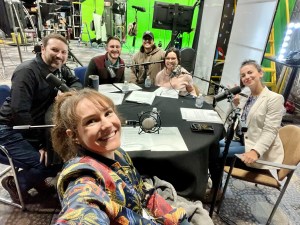
Host: I can’t with you, Kenna. This is—
[Laughs]
Kenna Pell: I know. And I avoid it every episode.
Host: It’s okay. It’s alright. Your job is out of this world.
[Laughs]
Kenna Pell: It’s a big part of the job here. You know, bringing it down to a level that anyone can understand, including how far Jupiter is from Earth.
Courtney Beasley: And that’s sometimes the most difficult part of our job. I have read articles, emails, and tried to translate them into layman’s terms and have just had to go back to the subject matter expert and say, “I need you to explain this to me on a second or third grade level.” And it helps so much. But there are times where you stumble upon that.
Host: You guys have like an anecdotal success story of reaching, maybe not just a broad audience and it could be a broad audience, right? It could be massive numbers of something that you didn’t realize would engage someone. Or it could be just a face-to-face interaction with someone where you’re trying to tell someone about something. I’ll start. The reason that I’m bringing up because I have one in mind. We were doing this was when I worked for public engagement for a little bit. That’s how I started my career, my full-time career here at NASA. And it just so happened that the Super Bowl was here in Houston. So NASA went all out. We were downtown, and there were all these different ways to engage. But one of the big things of why the Super Bowl’s in Houston is the space city side of things, right? Trying to engage people. And so we had exhibits and we had all these different things, and I was there just trying to engage some of the kids with some of the exhibits that we had set up. And I remember talking to one kid who was just like, his eyes were locked on everything. And I went up to him and I was just like, you know, “Do you think you would want to be an astronaut one day?” And he said, “Yeah, absolutely.” And I said, well listen. I was like, “We are planning. We are trying to get to Mars. We’re trying to get to the Moon, we’re trying to get to Mars. And if you study hard, if you pursue things that we’re passionate about, by the time you’re in college, by the time you’re pursuing degrees, by the time you’re looking for a professional job is very well that we could be seeking astronauts to walk on Mars.” And I said, “And you can be that person.” And just watching this kid just light up, just like I feel, I wish I could contact this kid. It was just a really like quick interaction with a bunch of other people that were there for these engagements. But I wish I could just follow up and be like, “Hey, have you like pursued extra science classes? Have you actually like kind of gone down that path based on this interaction?” And I just like watching this kid’s face light up, just be like, oh my gosh. Like, you have a potential to change, you know, people’s lives and perception of what we do. It was like super meaningful to me.
Courtney Beasley: I have a similar story. So actually just recently, and I would say it’s probably one of the most rewarding parts of my career so far, my daughter’s school asked me to speak for Space Week. So I had to do my research on some planets. I had to put some slides together. And I went to talk to her class. I showed them videos of astronauts on the space station, kind of dancing around and just really fun videos, throwing pizza to each other, catching M&M’s in people’s mouths and all of those fun videos. And I left just thinking, you know, that was kind of fun. And I really enjoyed it. I was like, I would love to speak to classes again. And it’s just really cool to see. And at the next school event we had, I had two moms walk up to me and tell me that their kids came home that day to say they wanted to be astronauts when they grew up after I spoke to the class. And these are three and four year olds, these are babies. And for them to even be processing what I said, I assumed I was going to go in there and no one was going to pay attention and it was going to be crazy. But they all sat and they listened and their eyes were just open so big and they were so happy, and it was just so rewarding. So I think while we are communicators and we’re telling stories and we’re putting out press releases, we’re also inspiring the youth, which is so, so rewarding and a piece that I really didn’t realize until those two parents came up and talked to me about that.
Host: I love that. Everybody’s got to have one. Come on. You guys have you like, okay. How about a broadcast, something you did?
Dane Turner: You know, the one thing that comes to mind is after DM-2 was done, I would go online and I’d try and see like how far of a reach did this get, especially with that being the first launch off American soil in nine years. Like, it was not just a big deal to me personally, because I was the one producing it for JSC, but it was a big deal for America. It was a big deal for the world to have another spacecraft that could go to the space station. And so I go online and I eventually found a thread that was with the video of the broadcast. And people were discussing it, talking about how cool it was and everything. But, you know, I’d put a lot of work into a lot of different aspects of this and to have seen people then commenting on things down to the choice of music to close out the broadcast, to find that these small decisions that I had made affected people, you know, that I’m never going to see, never going to talk to or anything, but just like they were engaging in all of these aspects of the broadcast, it’s one of those things that like, it really hits home then, you know, you’re not just throwing this into the ether. People are picking up on it.
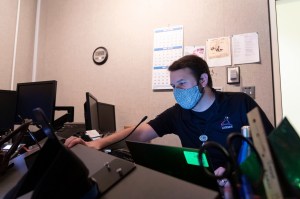
Host: I do find that both rewarding and very stressful. That’s actually one of the things about our job is the instant feedback.
Dane Turner: It can be terrifying.
Host: It can be terrifying. Yeah.
Leah Cheshier: Space enthusiasts, very opinionated.
Courtney Beasley: Leah, when I think of your career, a ton of things come to mind because you’ve done so many incredible things. But one of the things I think of, and it would be kind of cool to talk about, because it’s on the social media side, was the Moon Tunes campaign that you did. Because that absolutely blew up and ended up being a worldwide thing.
Leah Cheshier: Yeah. Well, you know, it was 2019 and we were celebrating the 50th anniversary of the Apollo 11 Moon landing. And so, you know, I think there are routes for everything that we do. We could post like a recap article and call it a day, you know, like we commemorated it, but how do we reach? And we had announced Artemis at that time. We weren’t calling it Artemis yet, but how do we reach this new generation and get them excited about not just what we did 50 years ago of bringing people to the Moon, but what do we do? What are we doing in the next, you know, five years even of sending people back around the Moon and eventually on the Moon? And so I wanted to do this. It was just such a fun idea. I mean, it was the lowest budget thing that we’ve ever done. I think I shot something on my cell phone of somebody in a suit saying like, “If you were on your way to the Moon, what would be on your playlist?” It’s this many hours to get there and you’re going to be around it for several days. And, you know, we worked with Third Rock Radio, we have a Space Act Agreement with them to take in suggestions. And I remember going to bed one night and it, we had announced it and I was so excited about it. And the next morning I woke up and it was trending on Twitter internationally. And it became a really, really big thing. So we ended up collecting, I think, almost 2 million inputs. And it ended up on news shows in India and in Mexico, and, you know, it was on one of the, maybe Good Morning America or Today or something, people just getting excited because it was a connection point for them. So they’re able to say like, “I’m so passionate about this music.” We had artists chiming in, you know? A-list celebrities of like, “This is what I’d send” or “Send my music.” And it was just an idea. It was not a promise of we’re sending anything, but just to get people excited and thinking about it was a connection point of meeting them where they’re at, you know, hey, everybody listens to music, you know, so let’s meet you in your music realm and say, here’s also what NASA is doing. So that was really inspiring of seeing how quickly that turned into an identification point for people. We had a big growth jump in our followership at that time, and so people that were initially attracted by this one idea, now get to follow what NASA’s doing. So I loved that one.
I did have one more day because we have a lot of audiences and beyond the public audience, we also have a media audience. You know, maybe somebody didn’t watch our NASA broadcast, but somebody might read one of the New York Times or CNN or something. And so Gary and I, we were lucky enough to go to Artemis I rollout before a wet dress rehearsal. Yeah. And I had several members of the media come up to me that day and say, “I really value your commentary that you do. I feel like you always do a good job covering it.” And I was just on cloud nine because these are people who have been around the industry for several years. And so for me to hear that they also find the information valuable and then can take that and expand the story also meant a lot to me.
Host: Yeah. I love the idea on the Moon Tunes, the identity. I mean, it’s like, to me, that’s really what brings it. It’s just like everybody gets your fingerprint. Everybody gets your, this is your identity as part of this mission. If you can get your song, you know? And you can imagine yourself on the way to the Moon listening to your song. Right. I love that. I think you have to find ways to have that in everything that we do, right, establish that connection. On commentary, creating some sort of bridge, or an anecdote when you’re, you know, like if media are saying that they appreciate what you’re just saying, that means you’ve described it in such a way that you’re transparent, that you can understand the story that you’re watching something, you know. You’ve successfully created that bridge. You’ve done a good job. And to hear that feedback, to hear that success, like, hey, I appreciate what you do. You do a great job, Leah. You really do.
Leah Cheshier: Thank you. Thank you. Yeah. I mean, I think I really like the identity topic too, because we do this a lot I mean, we do this with our outreach. You know, when we go to baseball games like Astros games and we do NASA night, we’re meeting people where they’re already at. I think that’s a thing that a good communicator and a good team has to look at. You know, we have astronaut downlinks for all kinds of events, for, you know, National Football Championship or whatever. And so I think NASA is also always looking for new audiences to share what we’re doing and how it is connected.
Host: Alright. I knew this would happen because we have excellent communicators here, but I’ve gone through one prompt so far.
[Laughs]
The next one I had was on, and I think we can all relate to this one, is International Space Station. I think, yeah, everyone has touched International Space Station here, whether you were Space Station, PAO, whether you’re strategic communications, whether you’re creating videos for space station. Everybody has touched this. And so, our job is to relay why it’s important. And I know this can be challenging. This can be a challenging thing to do because how do we start with an audience that sometimes ask the question, what is the International Space Station? How do you get there?

Kenna Pell: One thing that comes to mind is, you know, talking with school groups or just even people that maybe aren’t space enthusiasts, but just telling them that if you were born after November of 2000, so the Artemis generation, you’ve never lived on Earth with every other human at the same time. Which I think blows a lot of people’s mind. We’ve had continuous human presence on the Space Station coming up on, it’ll be 25 years in 2025 in November of ‘25. So we’re coming up on 24 now. And so we’ll have a big campaign for that, which is fun on the strategic communication side. But I think, you know, in everything we do, driving home what we call these sort of four pillars of the International Space Station. First being international cooperation, the second being benefits for humanity with all the science and research that takes place every day. It’s a test bed for low Earth orbit commercialization, and then Moon to Mars. So thinking of space station as everything for the future really is, is flowing through it right now. Different tech demos such as the toilet that’s going to be on Orion that goes to the Moon, things like that. And so I really have a fun time figuring out how to take those big, like we’re talking about those pillars and then those really scientific details and making them relevant to the everyday person. And we have a whole science communications team in ISS or in the ISS program that helps doing that too. On just the science side.
Host: That’s going to be a really hard way to bridge that communications is why is the science important? That’s one of the main things that we’re doing up there. The idea is you build this international fantastic laboratory that anyone can do science in space, but that could be so hard to grasp. It’s just like, why would you want to do science and space? What is the science in space? What does doing the science in low Earth orbit, what kind of value does that bring? That you can’t just do it on Earth? That could be a really challenging thing to bridge.
Leah Cheshier: Yeah. I mean, when you initially asked or put up this prompt of what are the challenges of, you know, communicating the International Space Station to a wide variety of audiences? You know, some people who don’t know that we have one or know the bare minimum. I think that the most important question in my mind that I hope to answer whether or not they remember anything about the CO2 scrubber or water reclamation, is why does it matter to me? So when you look, I mean, even let’s talk water reclamation. You know, we take what we have up there, water’s heavy to launch, we recycle it. So that means brine processors and, you know, purifying anything, any like evaporation or sweat and turning it back into consumable water, that translates to how can we provide water to remote communities down here on Earth that, you know, don’t have it in a great quantity or need some sort of an easy filtration system. What can we take that we’ve learned and put it into communities so people on Earth have clean drinking water? And so for me, they may not remember how we do that water reclamation on the space station, but I want them to remember the why it matters to them of, hey, they’re doing this work up there so that we can have better lives here on Earth. And so to me, when it comes to communicating the space station, that is the number one question in my mind that I always want to answer for people that they can walk away with.
Kenna Pell: I think we should pause for an advertisement from the Spot the Station mobile app, in case you didn’t know.
Leah Cheshier: Podcast was sponsored by Spot the Station.
[Laughs]
Kenna Pell: If you did not know, we have an International Space Station orbiting the Earth every 90 minutes and you can download the mobile application on whichever app store you use. And it’ll notify you, send you a push notification to your phone, about 15 minutes ahead, or 30 minutes ahead. You can set that and be able to walk outside and see it for yourself. If you don’t know, it’s the third brightest object in the sky when you look up, or if you know where to look. That’s what we say in the coffee.
Host: If you know where to look.
Kenna Pell: I think we say it’s the third brightest object in the sky if you know when to look up or something like that.
Host: Nice.
Kenna Pell: But that’s what the app’s for.
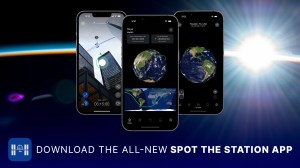
Host: Alright. And I’ll just say, I’ll caveat this because this is a NASA podcast, the app is free.
Kenna Pell: It’s free.
Host: No money from this. And it gets no royalties.
[Laughs]
Kenna Pell: It was a joke. This podcast is not sponsored by Spot the Station mobile app.
[Laughs]
Host: But it is good. It’s another way, like we’re talking about engagement, talking about communications. This is a way that you can engage. Identity, right? We talked about identity with Moon Tunes. Like you put your geographic location and it tells you based on where you are how you can look at the station. It’s very, very personalized.
Kenna Pell: Absolutely.
Courtney Beasley: For me, the International Space Station will always hold a special place in my heart because like Leah and Gary, it was our first beats in PAO. So I feel like I know what I know about NASA and the space station just because that’s the beat that we started in. I learned so much about everything at NASA through the International Space Station beat. I love to hear astronauts talk about the overview effect. I love to hear them talk about looking out the cupola window and looking down on Earth and seeing no borders. Whether it be religious state countries, they just look down and see it as one Earth. And I think that that’s something for people to remember. I also love, I work with the Artemis II crew, and I love hearing them talk about they would not be where they are with their mission going to the Moon if it weren’t for the International Space Station and how everything we’re learning on the International Space Station, they take with them in terms of science, in terms of human health and performance. We get to learn about how bodies adapt to space through long duration missions like Mark Vande Hei, Frank Rubio, Christina Koch. And I have just loved learning about all of that. And I remember being devastated when I was taken off the space station beat because I was like, what do you mean? I feel like I finally know everything that I need to know. I’m still learning so much every day. I’m so comfortable. But my work every day goes back to the International Space Station because that’s where we have humans right now. So I have just, I loved working on the space station beat. And again, I just love hearing the astronaut stories about their time there.
Host: That human aspect is I think what makes human spaceflight so special is just understanding that perspective. Hearing it from the astronauts aboard the International Space Station and their appreciation for Earth and no border. You talk about no border, you talk about nature. Dane, you and I are hearing this every month from the CHAPEA check-ins. I mean, they’re not even, they’re not even off the planet. They’re in a simulated habitat here. But they can’t stop talking about nature and just their appreciation for Earth. And just understanding that human connection to our planet. And that appreciation for it goes a long way. You know, you could talk about the science too, and the science obviously is, very, very important on what we’re doing. It could be hard to communicate. This is one that I think people can really resonate with, is understanding that connection to Earth.
Kenna Pell: And Gary, there’s one other thing I wanted to talk about with the space station was that, you know, a lot of times we say, and I was looking at the website so I could read it correctly, that the greatest achievement of the International Space Station program is as much a human achievement as it is a technological one. How best to plan, coordinate, and monitor the varied activities of many organizations and operations around the world. It’s very much that international cooperation part of it too.
Host: That international cooperation is so important. And I think a lot of us are spoiled because we’ve been with space station for so long that we understand this. But that value of just why we’re in space for so long is understanding and working out the kinks for sustainable models and helping this to go into the future. We’re seeing this for Artemis, we’re seeing the International Space Station model translate very well to Artemis international cooperation The commercial model and cooperation and commercial models translated to lunar, to deep space exploration. Because we’ve been there for so long sustainably what works, what doesn’t, how do we keep this going? How do we involve more people? How do we expand. Now look at the nation’s going to the Moon with us as part of the Artemis Accords. Everyone’s signing up. If we do it collaboratively, if we do it together, everybody has their footprint, identity as a part of it. Everybody’s can get behind it. And we do it not as a country, not with borders, but as people. And we’re seeing that with Artemis because it’s worked so well on the International Space Station, like decades of international partnerships with all these nations.
Courtney Beasley: We’re up to 42 nations who have signed the Artemis Accords now.
Host: It keeps increasing. That’s important.
Courtney Beasley: We have a great list going. Jeremy Hansen often says that we should be so proud of our country because the United States did not need Canada to get to the Moon, but it made the decision to include Canada. And we’re doing so with other countries. And of course, the model is all from the International Space Station.

Host: Yeah, one thing I think about, going to you Dane, is how spoiled we are with the International Space Station in low Earth orbit and the visuals. I think we are talking about this now. I think this is hard to characterize and we’re trying to set expectations here, is space station’s been there for a while, has a lot of different assets, has geosynchronous satellites that provide us really great high-definition coverage. We do not have that infrastructure everywhere in the solar system yet, we have that infrastructure in low Earth orbit. And so trying and being spoiled with all of the great things we’re getting from station, the high-bandwidth data capabilities that we have and have increased over time because of just improving that infrastructure because it’s been there for so long. Got to start from scratch for the Moon. So it’s just going to be harder. It’s going to be a lot different. And you know, as a multimedia producer, you have a lot to play with in low Earth orbit.
Dane Turner:. So one of the coolest things about when I was a live television producer here, every day you walk into the, the control room, our production control room and just on the screens are every down link from the station. You can just see inside the station, you see astronauts floating around. You see, you know, some of them working on science experiments. You see, you know, different modules. And then you can also see the cameras on the outside of the station. You can see the Sun coming up over the Earth limb. You can see that thin atmosphere on the curvature of the Earth. You can see, you know, the camera looking down on the Earth. And whether it’s day or night, you can see it going over these continents over the ocean. You see islands, you see the lights of cities. It’s just amazing to see these dozens of cameras that are on the space station. And you just have all of them in front of you. And part of your job during some of the broadcast is deciding which shot it is that tells the story best. You know? Is it this shot where you can see the sunrise? Or is it this shot where you see the astronauts, you know, on the outside of the space station doing an EVA and this is what, you know, what angle gets you their work best. And sometimes you do have to cut away from that and show their helmet shot where they’re looking down through, you know, the solar arrays down to the Earth and it’s like, I cannot leave this shot unshown to the world. Because it’s just, you know, this is what makes space special. And so, you know, when you’re up there in the control room and you’re doing a down link with the astronauts and they’re talking to children at a school and they’re explaining the science to the kids in, you know, terms that the kids can understand everything. And, you know, at some point you, this is just a job to, you know, us as producers, you know, we’re, we’re sitting there and yeah, we’re just pressing the buttons and everything. And then you realize, no, this is an astronaut 250 miles above us, talking to a school that’s somewhere in the world cause we’ve talked to schools across the U.S., we’ve talked to schools in Europe, in Canada. You know, we get schools all over the place that are getting to talk to the space station, and we’re the ones who are making the connection. We’re the ones pressing the button to bring the image from the space station down to Earth to these kids. And we’re inspiring these kids. It’s these connections and these visuals that just make this whole thing special.
Host: That’s why we’re spoiled.
Dane Turner: We really are.
Host: Yeah. Not every government agency gets those feeds. It’s actually, I do feel spoiled. I sit here our office, in our building, and I could pull up a TV which has feeds routed from Mission Control. And as I’m working throughout the day, I just have the space station orbiting the Earth. Every 90 minutes, sunrise, sunset. Beautiful. Like, where are we over now? Astronauts floating, doing their job. And I get that all day every day. Not every office is like that.
Dane Turner:. And sometimes you have to remind yourself like, this is where I work and this is what’s going on. And it’s like, how did this happen?
Kenna Pell: I will say for our listeners, there is publicly available live high-definition video views from the space station. You can just google YouTube live International Space Station views. So you can put those in the background. And sometimes I’ve got that too.
Host: And use the promo code “Kenna Pell.”
[Laughs]
Kenna Pell: Stop. Use the promo code “Spot the Station.” I’ll never forget my first downlink. I was at our International Space Station Research and Development Conference. And I’ll never forget that, just knowing that they’re talking to us live. Even if you’re not talking to them, but they’re talking to you in the room. I mean, I’ll never forget that.
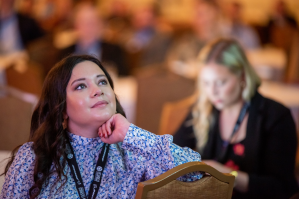
Courtney Beasley: Gary, before we run out of time, I want to talk about you and wish you a happy birthday because you’re the founder of the pod, correct?
Host: Yes, I am. Thank you.
Courtney Beasley: Do you remember?
Leah Cheshier: He’s seven now.
[Laughs]
Host: Going on this seven.
Kenna Pell: It’s his golden birthday.
Courtney Beasley: Do you remember going all the way back to when you had the idea? Who did you present it to? What did that presentation look like? How did it all get started? I want to hear about it.
Host: Oh, yeah. Well, let me start off by just saying thank you all for being a part of this. It is super meaningful to me and Courtney, I know you’re asking me the question because this is my baby. It started from the very beginning, and so to welcome new voices was something, you know, it needs to happen. It needs to happen. This is not Gary Has a Podcast. This is Houston We Have a Podcast. And there’s a lot of voices and a lot of stories to tell. And you guys each bring such unique and amazing perspective that I think needs to happen as part of this. But this was actually, so I’ve lived in Houston in at some point over or another for the past 12 years now. And, when I moved down here full-time with my now wife, we moved into the city and my commute got up to like 40 minutes. So I was trying to find ways to kill the time I was listening to music, but then I started diving into podcasts. They were free, so why not? So I started listening to them and of course, being interested in space, I started looking for space podcasts, found a couple of them, looked at NASA’s presence and it was not great.
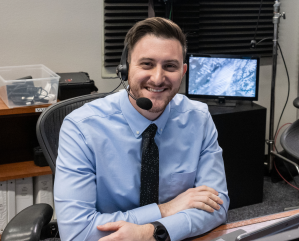
I was of course interested, but it didn’t really scratch the itch of what I wanted. And so that’s when the idea clicked. What if we just make one? And we still have this meeting to this day. It’s a meeting that happens. Actually Dane, you’re the executive producer for it, it’s called the Space Program. And it’s a way for us to constantly be thinking about what’s missing? What gaps do we need to fill? Because you can start really getting into the grind of just doing the same old thing all the time. But you always need to think about what’s missing and how do we fill those gaps? What audiences are we not reaching? What new technologies and capabilities are coming out? It was through this that we started doing Facebook Lives and Vines at the time, if you guys remember. But podcast was one of them. And so I put together, at the time, I was listening to things like an interview style, very informal, about an hour long. And those are the things that I was gravitating towards, the educational content. And so a lot of what Houston We Have Podcast is now was based off of pieces of what I liked from other podcasts and thought, let’s just see how this goes. And I got from, you know, being in public affairs and working with people across the center, I reached out to all of the people who I’ve worked with closest to record episodes of a podcast that didn’t exist yet, and asking an hour out of their time to say, would you sit down with me for a podcast? I don’t know if this can be a thing. Built out a bank of about 10 episodes and finally launched and it just took off.
Kenna Pell: Pun intended.
Courtney Beasley: How many episodes were you recording at the beginning and then just the cadence of it compared to now?
Host: I built up a bank of 10 before our first release, so that got us through two months on some change on a weekly cadence. And at that time, I think I was, we were about two months out, and then we got kind of closer at times because it wasn’t very short after we launched Houston We Have a Podcast that Harvey hit the city of Houston. And so that kind of shut everything down for a while and delayed our posting and everything. But after things got back up and we got back on a good cadence, we got a good stride for me. Originally, it was just me and Alex Perryman, who was the original audio producer. We now have Will Flato. But it was just me and Alex and we were both doing everything. And as we realized the pace of things we needed to expand the team. And that’s where we have the team that we have today with Dane producing every week, with Abby posting all the time, we have the social team, Jaden and Dominique, that constantly help us with the reaching out to as many people as possible. And it can’t happen without you guys. It just can’t. I try to make this is high quality and good as possible every week. And I just can’t do it can’t do it without you guys.
Courtney Beasley: Alright. Seven years in, give us your top couple of favorite episodes you’ve ever recorded.
Leah Cheshier: This one.
Courtney Beasley: Or else.
Host: This is number one. And then number two. No, there’s so many special ones. First time we did it from space, I got to talk to Jack Fischer. And he went all out for it. We did a hybrid Facebook Live at the time, and in between each question, Jack Fischer decided to stand on a new wall of the space station. And so he just slowly rotated throughout the whole podcast. That was really fun. The 300th episode, that was really, really special, just knowing that we did that for a long time. The Kathy Koerner episode was a big one, that was the Moon to Mars Architecture. That was a one of the few times where, you know, I go into this with an outline and with a script, but she was coming from some engagement in Europe, I believe.
Dane Turner: Yeah, it was in Europe.
Host: Yeah, it was. And she was talking with officials from all over and just came here charged because everybody in Europe was so excited. And she just came with this passion behind everything that she was saying, that it was one of the few times that I just dumped the script and just, we went off on a tangent, that was really special. And then one of the ones that comes to mind is there was Apollo samples in our lunar curation facility here at Johnson that they’ve been keeping for five decades. And I got to talk with the people that opened it and handled it for the first time. And that’s a really special thing to do. But what was the most special is hearing their emotions of every step of the way, waking up that morning, like getting the jitters, like being the one to actually like start handling the sample core. And just like, I felt like I was there, you know, those ones where you just sort of like, you build those bridges and you break down those barriers of, you know, what is it like to handle such a precious sample, such a precious rock. It was something that you can just like, be emotionally behind. It’s like you were there, it’s like you were cutting the sample. Those are really special episodes.
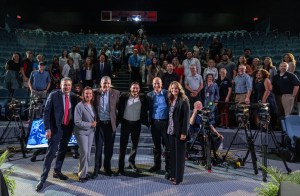
Courtney Beasley: I can’t imagine how much you’ve learned getting to record all of these because the two that I have done already, I feel like I’ve learned so much.
Host: Yeah. Now do that 300 times.
Courtney Beasley: Yeah. I can’t imagine.
[Laughs]
Host: Yeah. And there’s no topic that’s off limits. Remember when we talked to Psyche, when we talked to Lindy Elkins-Tanton about it’s a probe that’s going out and seeing a metallic asteroid. You know, it’s like, that’s not human spaceflight. Yeah. That’s not human spaceflight, but like, this is super cool. Let’s, let’s talk about it. Let’s figure it out. You just learn so much about everything. Nothing’s off limits.
Leah Cheshier: And on the topic of topics, I think your first episode was the International Space Station. Yes. As a whole, which is funny to think about now because we’re talking about all of the intricacies of the International Space Station. I think we could do an episode on cargo transfer bags, you know. How we get things up and down this from the space station. Obviously, you have to start out with an overview, and I think that’s the perfect one, you know, that represents so much of the work that we do here. But it is so funny. Seven years later, we will literally never, ever, ever run out of things to talk about on this podcast.
Host: That was not originally clear to me. Whenever I was were kicking it off. I was doing very generic kind of high-level stuff because I thought that’s where we needed to go. But slowly did I realize that our listenership are people that are loyal to understanding more and more and more. And I have a blast every time I come in here. This is like one of my favorite things to do because I’m always learning, always learning. So yeah, you’re right. I don’t think, as long as this podcast keeps going, there will always be new things to learn, always new topics to tackle. And you guys are the ones that are going to help me do it. This is great. Any topic you want. What are you guys looking forward to for the next year?
Courtney Beasley: I can’t wait to see who all I get to talk to. This is so exciting and fun.
Kenna Pell: Gary, you know, I appreciate you opening this up to other people to do it. And I remember we were sitting in this room where we’re at now, we didn’t audition, and he said, alright, you want to do it? And I’m like, are you serious? Like me?
Host: Yeah. Right afterwards.
Kenna Pell: I was the personality hire, everyone. I’m the one that stumbles over the words and no. Anyway. I do want to say, you know, now that I have a team member on my team helping with strategic comms for the International Space Station, I want to take on more, looking at more, I always say the human interest story. I hope that everyone here has enjoyed hearing from the comms folks and the background, but more about the jobs and stuff that we have here. And I know that we, we do that when we’re asking about these different scientific, you know, experiments and things like that. But man, the breadth of the jobs here is just crazy.
Host: That topic on unique careers is actually one that I think a lot of people want to hear. Dane, you’re doing it now with a video series, Cosmic Careers. You got to hang out with divers.
Dane Turner: I did, yeah. For the first episode, I went to the NBL, which we’ve got a new episode on just recently of this podcast. But for cosmic careers, I pitched to go to the NBL and to see if they wanted to talk to us about what it takes to be a diver. And, you know, they actually let me in the pool and we got to show what it really takes to be a diver there and to explore these careers, you know, it’s going to be really exciting to see where we can go with that and all the different careers at NASA, because as we all said, we didn’t realize that this, this is something you could do at NASA. We didn’t realize that communications at NASA was a thing. A lot of people, you know, they go diving as a hobby. They don’t know they could turn it into a career at NASA. You know, it’s all these little things that are absolutely necessary to human spaceflight that people just don’t realize that they could help contribute in their own little way, with their skillset, even if they aren’t STEM-based.
Kenna Pell: You know, we did an event here when Kjell Lindgren was on the space station, and they do these things called Crew Choice events, and he wanted to do one for that side of JSC, the jobs you don’t think about the ones that are really running the backbone of, you know, this center. So janitors, facilities, folks, security, and he had this downlink with just them to thank them for all that they do. And it was called Unsung Heroes of JSC. And I would say that was a really cool highlight of my job here at Johnson so far cause those people were so appreciative.
Host: There’s a lot that we can tackle. Like I said, no shortage of topics. And you guys are going to be the ones to help to, to, to do all of it. There’s a lot that I’m looking forward to with you guys. Thank you for being a part of this podcast. This is my baby and means the world to me. So you guys tackling this and being dedicated to continuing the story and putting out on a weekly cadence. It’s a lot to ask. It’s a lot. But the value is so apparent. So many people, it’s actually kind of nice. I’ve talked with a number of interns that come on, and a lot of them, like a lot of them have listened to this podcast before coming on. And some of them have even chose to intern at NASA because of this podcast. So, what we’re doing is super special. And thank you for coming on. That’s all I have for our seventh year. This is a long podcast. But, I really wanted folks to really understand the voices who’s going to be taking on the role of interviewing all these smart people and tackling all these topics. And so I’m very lucky to have all of you being the ones to do it. So thank you very much. Happy birthday to us, and see you next week.
[Music]
Host: Hey, thanks for sticking around. This podcast has been a very meaningful part of my life for quite a while, seven years. So I’m very happy to have these voices as part of the podcast. I hope you really enjoyed really getting to know them. I know each of them, they’re all fantastic people to work with, I certainly trust them to be voices of this podcast. And it’s truly something that, I think is necessary for the evolution of the podcast. I hope you learned something today. I hope you got to enjoy learning from each of the hosts and understand a little bit who of who they are, because I think you’re going to be hearing a lot more from them.
For more on podcasts and more on what we do at NASA, check out nasa.gov and nasa.gov/podcasts. You can check out Houston We Have a Podcast, our full collection of episodes, listen to any of them in no particular order, and check out the many other podcasts we have across the agency. On social media, we’re on the Johnson Space Center, pages of Facebook, X, and Instagram, and you can use #AskNASA on your favorite platform to submit an idea for the show or ask a question, just make sure to mention it’s for us at Houston We Have a Podcast.
This episode was recorded on June 7, 2024. Thanks to Will Flato, Abby Graf, Jaden Jennings, and Dominique Crespo for their help in the podcast every week. And of course, thanks again to Leah Cheshier, Kenna Pell, Courtney Beasley, and Dane Turner for a great chat today and their dedication to supporting Houston We Have a Podcast. Give us a rating and feedback on whatever platform you’re listening to us on and tell us what you think of our podcast. We’ll be back next week.
This is an Official NASA Podcast.












